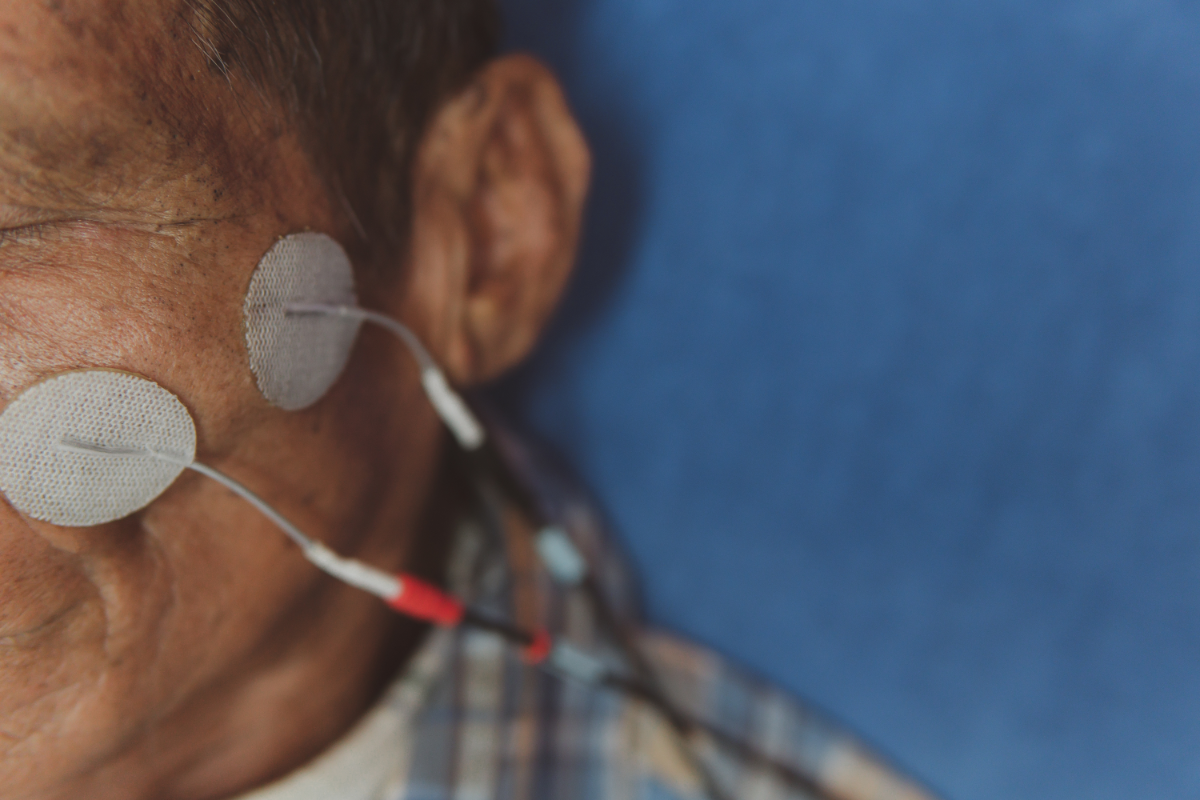Bell ‘s Palsy strikes suddenly, causing weakness or paralysis of the facial muscles. This often temporary condition can affect anyone, at any age, leaving many patients uncertain about its cause and treatment. In this comprehensive article, we take a deep dive into Bell’s palsy: from its precise medical definition to the signs and symptoms that accompany it, via the key steps for a reliable diagnosis and the treatment options currently available.
We’ll look at the latest research to understand why and how this condition occurs, as well as best practices for managing its symptoms and promote a full recovery. Whether you’re a patient, a family member or just looking for reliable information, this article aims to provide a comprehensive and accessible overview, with practical advice for those affected by Bell’s palsy. Find out more now and discover how best to manage this condition.
What is Bell’s palsy?
Bell’s palsy is a form of sudden , temporary facial paralysis that results from dysfunction of the facial nerve, also known as cranial nerve VII (1). This nerve is essential for the contraction of facial muscles, the sensation of taste on the front two-thirds of the tongue, and certain functions of the salivary and lacrimal glands. When this nerve is inflamed or damaged, it no longer functions properly, leading to weakness or paralysis of the facial muscles on the affected side.
Bell’s palsy is unique in that it develops rapidly, often in a matter of hours or days, and is generally unilateral, affecting only one side of the face. Patients may wake up with the sensation of a ‘frozen’ face or notice a distortion of their face when looking in a mirror. Although the exact cause remains unknown, researchers believe that Bell’s palsy may be linked to a viral infection, such as the herpes simplex virus, which also causes cold sores.
Symptoms of Bell’s palsy can range from mild weakness to complete paralysis and can include an asymmetric smile, difficulty closing the eye on the affected side, decreased sense of taste, a pulling or stiffening sensation in the face, hypersensitivity to sound in one ear and sometimes pain around the jaw or behind the ear on the affected side.
The good news is that the majority of patients make a full recovery with or without treatment. Recovery can begin within a few weeks or up to six months of the onset of symptoms. A small percentage of patients, however, may experience long-term sequelae or recurrence.
Bell’s palsy remains a mysterious condition in many ways, but research continues to shed new light on its mechanisms and treatments, offering hope and solutions for those affected.
How is Bell’s palsy diagnosed?
The diagnosis of Bell’s palsy generally begins with a thorough clinical examination (2). The doctor looks for weakness of both the upper and lower facial muscles, affecting only one side of the face – this includes the forehead, eyelid and mouth – which would have appeared in less than 72 hours. During this examination, the doctor will also rule out other potential causes of facial paralysis, as there is no specific laboratory test to confirm the diagnosis of Bell’s palsy.
Although laboratory or imaging studies are not systematically necessary, they can sometimes be useful in confirming the diagnosis or ruling out other conditions that may cause facial weakness, such as a brain tumour, stroke, myasthenia gravis or Lyme disease. If no specific cause is identified, the doctor may diagnose the condition as Bell’s palsy.
Tests that may be performed include:
- Electromyography (EMG), which involves the use of thin electrodes inserted into a muscle to assess variations in electrical activity during movement and at rest. EMG can confirm the presence of nerve damage and determine the severity and extent of nerve damage.
- Blood tests can sometimes help diagnose other concomitant problems, such as diabetes or certain infections.
- Diagnostic imaging, such as Magnetic Resonance Imaging (MRI) or computed tomography (CT), can rule out other structural causes of facial nerve compression (for example, an artery compressing the nerve) and check the condition of other nerves.
What are the symptoms of Bell’s palsy?
The main symptoms of Bell’s palsy are sudden weakness or paralysis of the muscles on one side of the face (3). These symptoms can lead to a range of changes and sensations, including but not limited to the following:
- Facial Sagging: The most characteristic sign is facial sagging, which can make it difficult to smile or close the eye on the affected side.
- Difficulty Expressing: Affected people may have difficulty expressing emotions, such as joy or sadness, due to muscle weakness.
- Abnormal Sensations: A tingling or stiff sensation may be felt on the affected part of the face before the onset of weakness or paralysis.
- Difficulty chewing: Paralysis can make chewing more difficult on the affected side and can sometimes result in accidental biting of the tongue or inside of the cheek.
- Altered Taste: Loss or alteration of the sense of taste on the anterior two-thirds of the tongue is possible.
- Eye Problems: Patients may have difficulty blinking or closing the eye completely, which may lead to dry eyes and an increased risk of irritation or infection.
- Hypersensitivity to Noise: Increased sensitivity to sound, or hyperacusis, may occur, making some everyday noises uncomfortably loud on the affected side.
- Pain: Some may experience pain around the ear or jaw, which may precede or accompany muscle weakness.
- Saliva or tear discharge: An increase in saliva or tears may be noted on the affected side.
It is important to note that these symptoms can vary in intensity in patients with Bell’s palsy. Some have only mild weakness, while others may have complete facial paralysis.
If you notice one or more of these symptoms, it is important to consult a doctor as soon as possible for a proper diagnosis and to start treatment as soon as possible to maximise the chances of a full recovery.
What causes Bell’s palsy?
Bell’s palsy, a sudden condition that affects the muscles of the face, remains shrouded in mystery as to its exact origins (4). However, experts suggest several possible causes:
- Viral infections the dominant theory suggests that a viral infection may be the trigger. The herpes simplex virus, which causes cold sores, is often cited as a potential cause. This virus can lie dormant in the body and later reactivate, causing inflammation and swelling of the facial nerve.
- Immune Response: It is also postulated that Bell’s palsy may result from an aberrant inflammatory response of the immune system. This reaction could mistakenly target the facial nerve as part of an autoimmune response.
- Genetic Risk Factors: Research has suggested a genetic predisposition in some individuals, making their facial nerve more vulnerable to paralysis triggers.
- Environmental Factors: Although less well documented, environmental factors, such as extreme stress or sudden changes in temperature, are sometimes thought to contribute to the onset of the disease.
- Pregnancy and Diabetes: Pregnant women, especially during the third trimester, or shortly after delivery, as well as people with diabetes, are considered to be at increased risk of developing Bell’s palsy.
- Trauma and Injury: Injury or trauma to the face can sometimes precede Bell’s palsy, suggesting a possible causal relationship in some patients.
It is important to note that in many cases the exact cause of Bell’s palsy cannot be determined. The condition is then classified as idiopathic, meaning that it occurs unexpectedly, with no obvious cause.
What are the long-term symptoms of Bell’s palsy?
Although Bell’s palsy is generally temporary, some patients may experience persistent (5) or long-term symptoms that can affect their quality of life:
- Synkinesia: Synkinesia is one of the most common long-term symptoms of Bell’s palsy, manifesting as involuntary facial movements. For example, winking while trying to smile.
- Facial Contracture: In some cases, facial muscles may contract permanently, causing facial tension and deformity that can be both uncomfortable and visually noticeable.
- Tearing or Dry Eye: Persistent problems with tears, such as excessive tear discharge or, conversely, dry eye, may result from incomplete healing of the facial nerve.
- Hypertonia or Muscle Weakness: Some rigidity or weakness of the facial muscles may persist, even after recovery of most nerve function.
- Difficulties with Speech and Feeding: Speech and chewing problems may continue to affect some patients, particularly when recovery is incomplete.
- Pain or Discomfort: Facial pain or tingling sensations may persist long after the acute phase of the disease.
- Psychological Problems: Long-term visible symptoms may also have a psychological impact, leading to lowered self-esteem or depression in some patients.
It is important to note that the majority of patients with Bell’s palsy recover completely with no long-term effects. However, around 30% of patients may experience varying degrees of persistent symptoms. Rehabilitation through physiotherapy and other therapeutic interventions can help to minimise these long-term symptoms and improve the quality of life of those affected.
How is Bell’s palsy treated?
The management of Bell’s palsy varies according to the severity of symptoms and the patient’s general state of health (6). The main therapeutic approaches are as follows:
- Antiviral drugs and corticosteroids: Treatment may include antiviral drugs in combination with corticosteroids to reduce inflammation and swelling around the facial nerve.
- Physical Therapy: Facial physiotherapy exercises are often recommended to maintain muscle tone and stimulate the facial nerves.
- Eye Protection: If you have difficulty blinking, it is important to protect your eyes with goggles or artificial tears to prevent dry eyes.
- Surgery: In rare cases, if conventional treatments are not effective and significant nerve damage is present, surgery may be considered.
- Psychological follow-up: Psychological assistance may be offered to help manage the emotional aspects of the disease.
What natural remedies and alternative approaches are there for paralysis?
In addition to medical treatments, some people with Bell’s palsy may turn to natural remedies (7) and alternative approaches:
- Acupuncture: This traditional Chinese practice, which involves inserting fine needles into specific points on the body, is used by some to improve nerve and muscle function.
- Vitamins B12, B6 and Zinc: Supplements of B vitamins and zinc may support nerve health, although their effectiveness in treating Bell’s palsy is not clearly established.
- Homeopathy: Some people use homeopathy for its potential beneficial effects on the symptoms of Bell’s palsy, although there is no solid scientific evidence to support its effectiveness.
- Aromatherapy and Essential Oils: The use of essential oils, such as lavender or chamomile oil, can help with relaxation and stress management, which is a possible aggravating factor in the condition.
- Relaxation and Stress Reduction Techniques: Meditation, yoga and other relaxation techniques can help reduce stress, which may have a positive influence on recovery.
It is crucial to consult a doctor before trying natural remedies or alternative approaches to ensure that they are safe and suitable for the patient’s specific situation. Self-treatment without medical advice can lead to delays in conventional care and potentially worsen the condition.
Is rehabilitation necessary for Bell’s palsy?
Rehabilitation is a central aspect of the treatment of Bell’s palsy, recognised for its effectiveness in the functional recovery of patients (8). It is based on several axes:
- Functional re-education: This aims to preserve muscle elasticity and stimulate the facial nerves through targeted exercises. These are often guided by a specialist physiotherapist.
- Electrical Rehabilitation although its effectiveness is open to debate, electrical stimulation of facial muscles can be proposed in certain cases to prevent muscle atrophy.
- Biofeedback: Using biofeedback can help patients to become aware of their facial muscle activity, allowing better control during rehabilitation exercises.
- Facial Massage: Gentle massage can be beneficial in reducing muscle tension and promoting blood flow to affected areas.
- Facial mimicry: Regular facial mimicry in front of a mirror helps to recover facial symmetry and reappropriate expressions.
- Relaxation techniques: These help to reduce stress, a factor that can influence nerve recovery.
Re-education should be started as soon as possible and adapted to each individual case, ideally under the supervision of a health professional. It plays a crucial role in reducing after-effects and improving facial function.
What diet should be adopted for Bell’s palsy?
Diet can play a supportive role in the treatment of Bell’s palsy, although there is no recognised specific diet for this condition. However, certain nutritional principles may be beneficial:
- Rich in B Vitamins: These vitamins are essential for nerve health. Including foods rich in vitamin B6 and B12, such as green leafy vegetables, fruit, legumes, meat and eggs, is recommended.
- Anti-inflammatory foods: Opting for a diet rich in omega-3 fatty acids, found in oily fish, flaxseed and walnuts, can help reduce systemic inflammation.
- Hydration: Drinking enough water is fundamental to maintaining good hydration, especially if taking in food and drink is made difficult by weak facial muscles.
- Antioxidants: Colourful fruit and vegetables, rich in antioxidants, can help protect cells from damage.
- Easy-to-eat foods: If you have difficulty chewing or swallowing, choose soft or liquid foods, such as soups, smoothies and compotes.
- Avoid Alcohol and Caffeine: These substances can aggravate inflammation and dehydration.
- Control Sugar: Maintaining stable blood sugar levels can be important, especially if corticosteroids are prescribed, as they can increase the risk of diabetes.
- Vitamin C (9) : The importance of vitamin C in the prevention of Bell’s palsy is highlighted by studies suggesting that vitamin C deficiency may be a risk factor or trigger for the condition. Conversely, Bell’s palsy may also be caused by vitamin C deficiency. It is therefore advisable to monitor the levels of vitamin C in the serum of each patient suffering from Bell’s palsy. Increased consumption of vitamin C-rich foods is recommended for the general population, particularly in those with risk factors for Bell’s palsy, as well as in patients already affected. Supplementation with vitamin C tablets should only be considered in cases of proven deficiency following blood analysis.
It is advisable to consult a nutritionist to adapt the diet to individual needs and to ensure that all the necessary nutrients are consumed in sufficient quantities.
How can Bell’s palsy be prevented?
Preventing Bell’s palsy can be complex, as its exact causes are often unknown. However, certain preventive measures (10) can be suggested to reduce the risk of occurrence or recurrence:
- Stress management: Stress appears to be a contributing factor in Bell’s palsy. Regular practice of relaxation techniques such as meditation, yoga or breathing exercises can help reduce stress.
- Infection Care: Prompt treatment of infections, particularly ear infections or viral infections such as herpes simplex, can prevent inflammation that can affect the facial nerve.
- Protection from the cold: Some studies suggest that exposure to the cold may be a triggering factor. Protecting yourself from the cold with scarves and hats can potentially help.
- Balanced diet: A diet rich in vitamins, minerals and essential fatty acids can support nerve health and, by extension, reduce the risk of nerve disorders.
- Facial Exercise: Although there is no definitive evidence, some health professionals suggest that regular facial exercise may help maintain good blood flow around the facial nerve.
- Medical monitoring: For those who have already had Bell’s palsy, medical monitoring can help to identify and treat any early warning signs of a recurrence.
It is important to note that these measures do not guarantee complete prevention, but they can help reduce the risk. It is always advisable to consult a healthcare professional for personalised advice.
Duration and recurrence of Bell’s palsy
Bell’s palsy is a condition of variable duration. In the majority of cases, symptoms gradually subside and improvement is often observed after three weeks. In fact, up to 80% of patients make a complete recovery without showing any residual signs of the disease within three months.
However, Bell’s palsy can reappear later in life. This occurs in around 5-10% of people who have already been affected by the condition.
Is Bell’s palsy permanent?
In most cases, Bell’s palsy is not permanent. Over time, normal facial muscle function is likely to be fully restored, which is the case for around 80% of people with the condition.
However, in some patients, facial weakness may persist for a prolonged period. The longer the period before improvement begins, the greater the risk of lasting sequelae. Risk factors associated with poorer outcomes include:
- Complete facial paralysis.
- Age over 60.
- Decreased salivation or taste perception.
This information is essential for anyone affected by Bell’s palsy or who knows someone in this situation to understand. They underline the importance of early diagnosis and appropriate treatment to optimise the chances of full recovery.
Source:
- https://www.ninds.nih.gov/health-information/disorders/bells-palsy
- https://pubmed.ncbi.nlm.nih.gov/29493915/
- https://www.ncbi.nlm.nih.gov/pmc/articles/PMC9648613/
- https://www.ncbi.nlm.nih.gov/pmc/articles/PMC7320932/
- https://www.ncbi.nlm.nih.gov/pmc/articles/PMC8702389/
- https://www.ncbi.nlm.nih.gov/pmc/articles/PMC5478391/
- https://www.ncbi.nlm.nih.gov/pmc/articles/PMC7231844/
- https://www.ncbi.nlm.nih.gov/pmc/articles/PMC8831488/
- https://www.ncbi.nlm.nih.gov/pmc/articles/PMC9548320/







